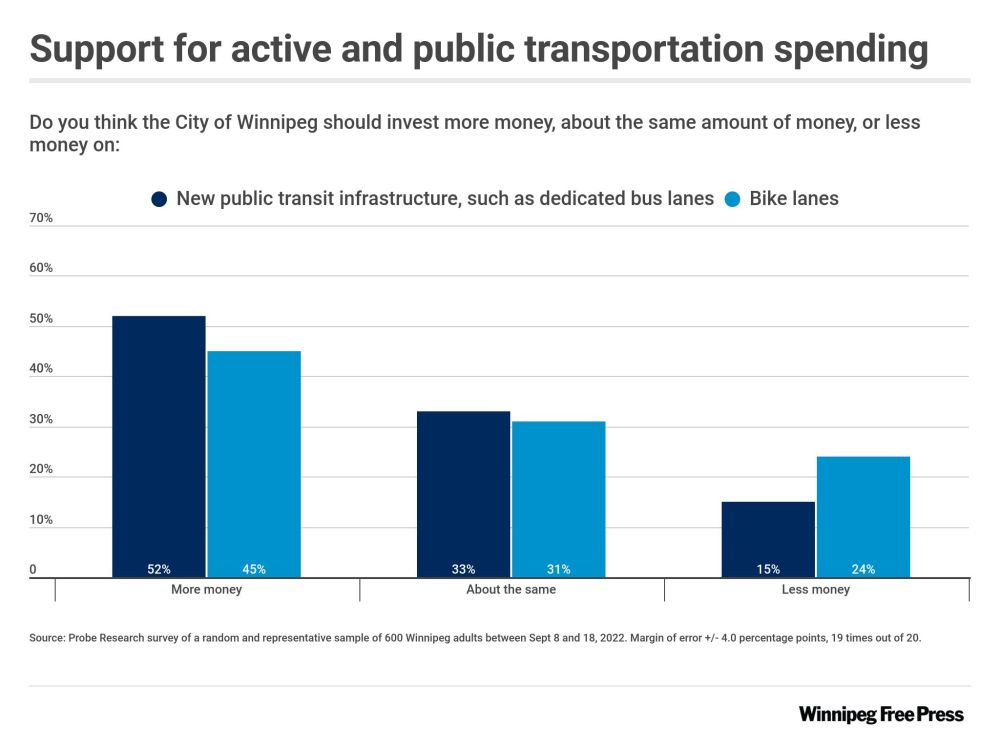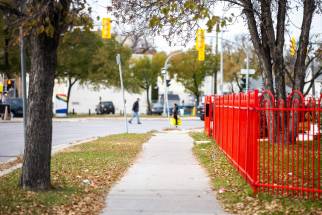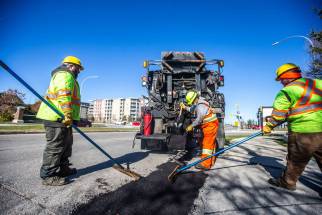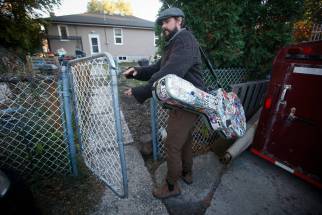Winnipeggers on board with transit improvements
Read this article for free:
or
Already have an account? Log in here »
To continue reading, please subscribe:
Monthly Digital Subscription
$0 for the first 4 weeks*
- Enjoy unlimited reading on winnipegfreepress.com
- Read the E-Edition, our digital replica newspaper
- Access News Break, our award-winning app
- Play interactive puzzles
*No charge for 4 weeks then price increases to the regular rate of $19.00 plus GST every four weeks. Offer available to new and qualified returning subscribers only. Cancel any time.
Monthly Digital Subscription
$4.75/week*
- Enjoy unlimited reading on winnipegfreepress.com
- Read the E-Edition, our digital replica newspaper
- Access News Break, our award-winning app
- Play interactive puzzles
*Billed as $19 plus GST every four weeks. Cancel any time.
To continue reading, please subscribe:
Add Free Press access to your Brandon Sun subscription for only an additional
$1 for the first 4 weeks*
*Your next subscription payment will increase by $1.00 and you will be charged $16.99 plus GST for four weeks. After four weeks, your payment will increase to $23.99 plus GST every four weeks.
Read unlimited articles for free today:
or
Already have an account? Log in here »
Hey there, time traveller!
This article was published 21/10/2022 (1142 days ago), so information in it may no longer be current.
The wheels on the bus aren’t going round and round as efficiently as Winnipeggers would like. And, according to a recent poll, more than half of residents want to see more investment in transit infrastructure.
Results from a recent Probe Research poll, jointly commissioned by the Free Press and CTV News, showed 52 per cent of respondents supported increased spending on things such as bus lanes, while 33 per cent were satisfied with the current budgetary allotment and 15 per cent wished for less spending.
It’s a slim majority, but in this car-centric city, any endorsement of public transportation is notable — especially since the majority of residents don’t ride the bus regularly.
Transit ridership declined during the pandemic and remains well below normal operating levels, creating a $15 million shortfall for the department this year. Financially, the city needs more people on buses. Practically, services need to improve in order to boost ridership. It’s a chicken-and-egg conundrum Winnipeg’s incoming mayor and council will need to unscramble.
Currently, taking the bus in this city is an exercise in frustration. Stops are few and far between, routes are indirect, transfers are often required, the fare structure is confusing and busing can take considerably longer than driving to the same destination. Assuming, that is, the bus even arrives.
These are a few of the sticking points identified in the Winnipeg Transit Master Plan, a 25-year planning document adopted by city council last spring that aims to make public transportation more accessible and attractive. Twenty-five years might seem like a lengthy timeline, but transit improvements here tend not to take the express route.
One example is the rapid transit system, which has been a political talking point for decades and has been growing at a snail’s pace since the first phase came online in 2012. The second phase of the southwest transitway opened in 2020, and there are two more corridors proposed. While some expansion can make use of existing roadways, special lanes and stations are needed to complete the network.
Based on the aforementioned poll, there’s an appetite for this kind of major infrastructure investment. Based on the aforementioned shortfall, there’s little in the coffers to support said investment.
Based on the aforementioned poll, there’s an appetite for this kind of major infrastructure investment. Based on the aforementioned shortfall, there’s little in the coffers to support said investment. Federal and provincial funding is required to make the transit master plan a reality.
Large-scale improvements, including expanded rapid transit lines, are necessary to bring Winnipeg on par with other major Canadian cities, but they’re only one piece of the people-moving puzzle. Less costly revisions to the user experience are also needed to build ridership.
Earlier this year, the city released a Winnipeg Transit app that allows riders to plan trips and check route schedules. But as yet, it’s not a one-stop shop. Real-time updates are lacking, and users still need to navigate a City of Winnipeg webpage to manage their Peggo account — a frustratingly flawed online fare system that would make even the most tech-savvy commuters opt for a different mode of transportation.
Just as the Peggo system is in desperate need of an overhaul, much of the city’s existing bus network requires re-imagining. The hub-and-spoke model that sees most routes converging downtown no longer makes sense. Commuters need better crosstown connections and reliable service. These are things that shouldn’t take 25 years to implement.
There will undoubtedly be more bumps on the road to adequate transit service, but in order to make this city a more livable and connected place, and also one that does its part in addressing climate change, Winnipeg’s next mayor and council need to make public transportation a priority.










